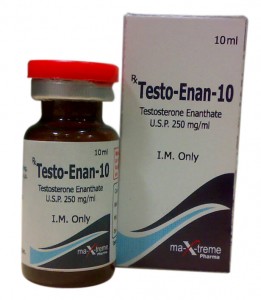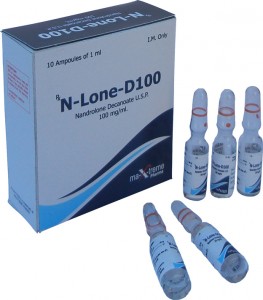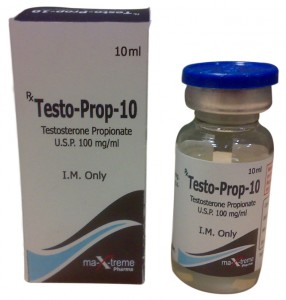 Testosterone Enanthate Injection, provides testosterone enanthate, a derivative of the primary endogenous androgen testosterone.
Testosterone Enanthate Injection, provides testosterone enanthate, a derivative of the primary endogenous androgen testosterone.
Endogenous androgens are responsible for the normal growth and development of the male sex organs and for maintenance of secondary sex characteristics. These effects include growth and maturation of prostate, seminal vesicles, penis, and scrotum; development of male hair distribution, such as beard, pubic, chest, and axillary hair; laryngeal enlargement; vocal chord thickening; alterations in body musculature; and fat distribution.
Androgens also cause retention of nitrogen, sodium, potassium, and phosphorus, and decreased urinary excretion of calcium. Androgens have been reported to increase protein anabolism and decrease protein catabolism. Nitrogen balance is improved only when there is sufficient intake of calories and protein.
Androgens are responsible for the growth spurt of adolescence and for the eventual termination of linear growth which is brought about by fusion of the epiphyseal growth centers. In children, exogenous androgens accelerate linear growth rates but may cause a disproportionate advancement in bone maturation. Use over long periods may result in fusion of the epiphyseal growth centers and termination of the growth process. Androgens have been reported to stimulate the production of red blood cells by enhancing the production of erythropoietic stimulating factor.
During exogenous administration of androgens, endogenous testosterone release is inhibited through feedback inhibition of pituitary luteinizing hormone (LH). At large doses of exogenous androgens, spermatogenesis may also be suppressed through feedback inhibition of pituitary Follicle Stimulating Hormone (FSH).
There is a lack of substantial evidence that androgens are effective in fractures, surgery, convalescence, and functional uterine bleeding.
INDICATION
(Testosterone Enanthate Injection) is indicated for replacement therapy in conditions associated with a deficiency or absence of endogenous testosterone.
Primary hypogonadism (congenital or acquired) –Testicular failure due to cryptorchidism, bilateral torsion, orchitis, vanishing testis syndrome, or orchidectomy.
Hypogonadotropic hypogonadism (congenital or acquired) – Idiopathic gonadotropin or luteinizing hormone-releasing hormone (LHRH) deficiency, or pituitary-hypothalamic injury from tumors, trauma, or radiation. (Appropriate adrenal cortical and thyroid hormone replacement therapy are still necessary, however, and are actually of primary importance.)
If the above conditions occur prior to puberty, androgen replacement therapy will be needed during the adolescent years for development of secondary sexual characteristics. Prolonged androgen treatment will be required to maintain sexual characteristics in these and other males who develop testosterone deficiency after puberty.
Delayed puberty – (Testosterone Enanthate Injection) may be used to stimulate puberty in carefully selected males with clearly delayed puberty. These patients usually have a familial pattern of delayed puberty that is not secondary to a pathological disorder; puberty is expected to occur spontaneously at a relatively late date. Brief treatment with conservative doses may occasionally be justified in these patients if they do not respond to psychological support. The potential adverse effect on bone maturation should be discussed with the patient and parents prior to androgen administration. An X-ray of the hand and wrist to determine bone age should be obtained every six months to assess the effect of treatment on the epiphyseal centers .
Females
Metastatic mammary cancer – (Testosterone Enanthate Injection) may be used secondarily in women with advancing inoperable metastatic (skeletal) mammary cancer who are one to five years postmenopausal. Primary goals of therapy in these women include ablation of the ovaries. Other methods of counteracting estrogen activity are adrenalectomy, hypophysectomy, and/or antiestrogen therapy. This treatment has also been used in premenopausal women with breast cancer who have benefited from oophorectomy and are considered to have a hormone-responsive tumor. Judgment concerning androgen therapy should be made by an oncologist with expertise in this field.





 Anabolic steroids are synthetic derivatives of testosterone. Certain clinical effects and adverse reactions demonstrate the androgenic properties of this class of drugs. Complete dissociation of anabolic and androgenic effects has not been achieved. The actions of anabolic steroids are therefore similar to those of male sex hormones with the possibility of causing serious disturbances of growth and sexual development if given to young children. Anabolic steroids suppress the gonadotropic functions of the pituitary and may exert a direct effect upon the testis.
Anabolic steroids are synthetic derivatives of testosterone. Certain clinical effects and adverse reactions demonstrate the androgenic properties of this class of drugs. Complete dissociation of anabolic and androgenic effects has not been achieved. The actions of anabolic steroids are therefore similar to those of male sex hormones with the possibility of causing serious disturbances of growth and sexual development if given to young children. Anabolic steroids suppress the gonadotropic functions of the pituitary and may exert a direct effect upon the testis. Stanozolol is one of the anabolic steroids commonly used as performance enhancing drugs and is banned from use in sports competition under the auspices of the International Association of Athletics Federations (IAAF) and many other sporting bodies. Additionally, stanozolol has been used in US horse racing
Stanozolol is one of the anabolic steroids commonly used as performance enhancing drugs and is banned from use in sports competition under the auspices of the International Association of Athletics Federations (IAAF) and many other sporting bodies. Additionally, stanozolol has been used in US horse racing Nandrolone phenylpropionate is an injectable form of the anabolic steroid nandrolone. The properties of this drug are strikingly similar to those of Deca-Durabolin, which uses the slower acting drug nandrolone decanoate. The primary difference between these two preparations is the speed in which nandrolone is released into the blood. While nandrolone decanoate provides a release of nandrolone from the area of injection lasting approximately 3 weeks, nandrolone phenylpropionate is active for only about a week. In clinical situations, Deca-Durabolin can thus be injected once every 2 or 3 weeks, while Durabolin is usually administered every several days to once weekly. Otherwise, the two drugs are virtually interchangeable. Like Deca-Durabolin is valued by athletes and bodybuilders for its abilities to promote strength and lean muscle mass gains without significant estrogenic or androgenic side effects.
Nandrolone phenylpropionate is an injectable form of the anabolic steroid nandrolone. The properties of this drug are strikingly similar to those of Deca-Durabolin, which uses the slower acting drug nandrolone decanoate. The primary difference between these two preparations is the speed in which nandrolone is released into the blood. While nandrolone decanoate provides a release of nandrolone from the area of injection lasting approximately 3 weeks, nandrolone phenylpropionate is active for only about a week. In clinical situations, Deca-Durabolin can thus be injected once every 2 or 3 weeks, while Durabolin is usually administered every several days to once weekly. Otherwise, the two drugs are virtually interchangeable. Like Deca-Durabolin is valued by athletes and bodybuilders for its abilities to promote strength and lean muscle mass gains without significant estrogenic or androgenic side effects. Testosterone propionate is a commonly manufactured, oil-based injectable testosterone compound. The added propionate ester will slow the rate in which the steroid is released from the injection site, but only for a few days. Testosterone propionate is therefore comparatively much faster acting than other testosterone esters such as cypionate or enanthate, and requires a much more frequent dosing schedule.
Testosterone propionate is a commonly manufactured, oil-based injectable testosterone compound. The added propionate ester will slow the rate in which the steroid is released from the injection site, but only for a few days. Testosterone propionate is therefore comparatively much faster acting than other testosterone esters such as cypionate or enanthate, and requires a much more frequent dosing schedule. Testosterone Enanthate Injection, provides testosterone enanthate, a derivative of the primary endogenous androgen testosterone.
Testosterone Enanthate Injection, provides testosterone enanthate, a derivative of the primary endogenous androgen testosterone.